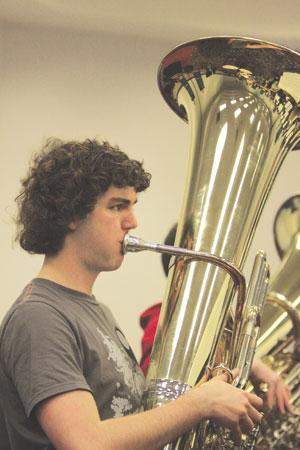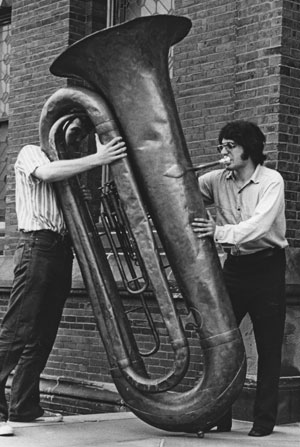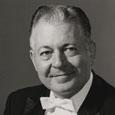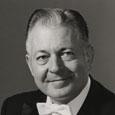Any band director can expand the tonal resources of his ensemble by adding a rich tonal dimension known as the Super Seven, the bottom seven keys of the piano keyboard to his group. This sub-bass range of pitches takes over from the E1 of the BB-flat tuba to the bottom, and it can be accomplished without the use an expensive contrabassoon or contrabass clarinet. These tones can be produced by two different methods on standard three-valved E-flat and BB-flat tubas or sousaphones.

Using Pedal Tones
While Berlioz was the first to indicate pedal tones for trombone in one of his scores, educators have never clearly defined the use of pedal tones to extend the range of the tuba, partly because of the use of tubas of different pitch in Europe and America. A pedal tone is one octave below the lowest open tone in the regular playing register in low brass instruments; it results from a single oscillating wave in a tube.
An open pedal can be valved down chromatically just like any other open tone. The low register of the BB-flat tuba has a gap of an augmented fourth from E1 down to the pedal B-flat 0.
.jpg)
These missing notes can be covered by playing the pedal tones on an the E-flat tuba.
.jpg)
Although an E-flat tuba will also have at least an additional pedal B flat and A, available, it is best to have the BB-flat tuba can pick up where the BB-flat pedals begin. Experienced tubists can produce a continuous range of pedal tones on the BBb tuba, below the piano range to G0, that are consistent in quality and accurate in intonation before the limitations of breath and mouthpiece size end practical tone production.
.jpg)
It’s best to use one E flat and one BB-flat tuba to specialize in producing these sub-bass tones because all of these tones are actual pedal tones. Directors can also team up an Eb tuba with a C tuba, which is now being included in more American bands. With this instrumentation the E-flat tuba fills in only EE-flat, DD, and DD-flat to bridge to the CC pedal on the C tuba.
After learning about pedal tones, some tuba students will inadvertently play an in-between sound as they fish for a pedal tone. It is a less-focused tone half way between the fundamental and the first overtone or key tone. Professional players may refer to it as a ghost or fog tone; it is more correct to call it a false pedal.
For directors who don’t have an Eb tuba, these false pedal tones can fill in the span. The open fog tone is either an EE or an EE flat, depending on the bore of the tuba. If an open false pedal turns out to be E-flat 1, it would be the same tone as the pedal on the Eb tuba. If the open fog tone centers more on an EE, the fingering going down would be a half step lower.
These false pedals are more effective on a large bore tuba and can provide an alternate way to produce these low tones. Although they may feel somewhat unfocused and loose, players can control them through careful practice by comparing their sound to the same tones played an octave higher by another tubist.
Four and Five Valve Tubas
The same magnificent sub-bass tones made on three valve tubas are also possible on more sophisticated four and five valve tubas. The fourth valve lowers the pitch by a perfect fourth, and the fifth valve usually lowers the pitch by a sharp minor third. It is easier to understand this by thinking of the fourth valve as transforming the instrument to a tuba in low F. In this case, however, the first three valves are woefully short. They need to be one- half times longer to function correctly. The result is severe sharpness that requires adding another half step to the process; this in turn over compensates causing flatness. Thus, the tubist has to correct most of the tones by manipulating the tuning slide. Professional tubists usually use the first valve slide for this purpose. Note that low B0 is not available on the four valve tuba because the half step is added on the way down.
.jpg)
In an ongoing attempt to correct these problems, instrument makers added a fifth valve that is usually an expanded whole step or a sharp minor third. Each tubist has to decide on the amount of slide pulling he needs to achieve for correct intonation.
.jpg)
Compensating Tubas
It would be remiss not to mention compensating four valve tubas. The fourth valve lowers the pitch a perfect fourth to FF. The tube is then positioned back through the first three valves, adding tubing to each valve and creating the correct lengths for the FF tuba with the fourth valve depressed. Thus, it is possible for a tubist to play a complete chromatic scale down to the pedal Bb. Although this seems to be the best way to get these sub-bass tones, this compensating BBb tuba has not caught on in the United States, probably because it is expensive, unwieldy, and the longer winding tubing produces a bit of a stuffy sound.
Suggestions for Band Directors
Band directors should carefully consider both the frequency and the artistic implications of adding these sub-bass sounds. They are slower to respond and require more air to sustain than notes in the general playing range of the tuba, and they should be used only in consecutive tones played slowly and deliberately. Sustained pedal points and climactic chords can be expanded by doubling them; however, their value and effectiveness diminish the more you use them. Fortunately, isolated pedal points are easy to hear and their presence is easy to feel. Listeners can sense a soft, sustained pedal by a single player played against several tubas on the octave above.
I recommend that only one tuba in a section play in this register, especially if it is a fog tone on a BB-flat instrument, because more care is necessary to center the pitch and lock into the octave above. Over the years my tuba colleagues in the United States Navy Band realized that using only one lip, shifting the embouchure either up or down, provided a firm base from which to initiate the slower oscillations in the tube. My suggestion is that each player experiment and find out which way to adapt his embouchure; the end result may depend on his facial features.
Adding New Sounds
School band directors interested in adding a sub-bass sound to their ensemble should start their selected players with the open pedals on both the E-flat and BB-flat instruments. First students should work to establish the amount of embouchure shifting, and then try for good attacks and long tones. The E-flat tubist should work his way down to a pedal C flat, mastering one half step at a time; the BB tubist can try for an pedal A and Ab. By working together they can cover the sub-bass tones to below the piano range.
If only a three valve BB-flat tuba or Sousaphone is available, the student should begin the same way by practicing the pedal tone using a shifted embouchure. Next, he should find the false pedal by relaxing the regular embouchure sufficiently and determing wehther it is an E or E flat . When the open fog tone is strong, playing down the chromatic scale should be simple and sound satisfactory.
I propose that directors consider adding these sub-bass tones judiciously to the bottom of a work as one of the prerogatives of the interpreter – the conductor – in his task of producing an effective performance of a composition. It is a fair assumption that the composer or arranger did not know these tones to be available and would have used them had he known them to be universally available. When the tones are included, doubled at the octave, they are not really new tones in the basic harmony but meant to embellish the bottom line of a work.
If any doubt remains with busy band directors as to the merits of adding this capability to the tuba section, I suggest you try one experiment. Simply ask one BB-flat tubist to play his open pedal B flat underneath a full B-flat chord with the band. You will hear an entirely new, commanding depth of sound.
 Another option is to track down a double tuba, such as this one owned by Harvard University and played by Sam Pilafian in this photo.
Another option is to track down a double tuba, such as this one owned by Harvard University and played by Sam Pilafian in this photo.






